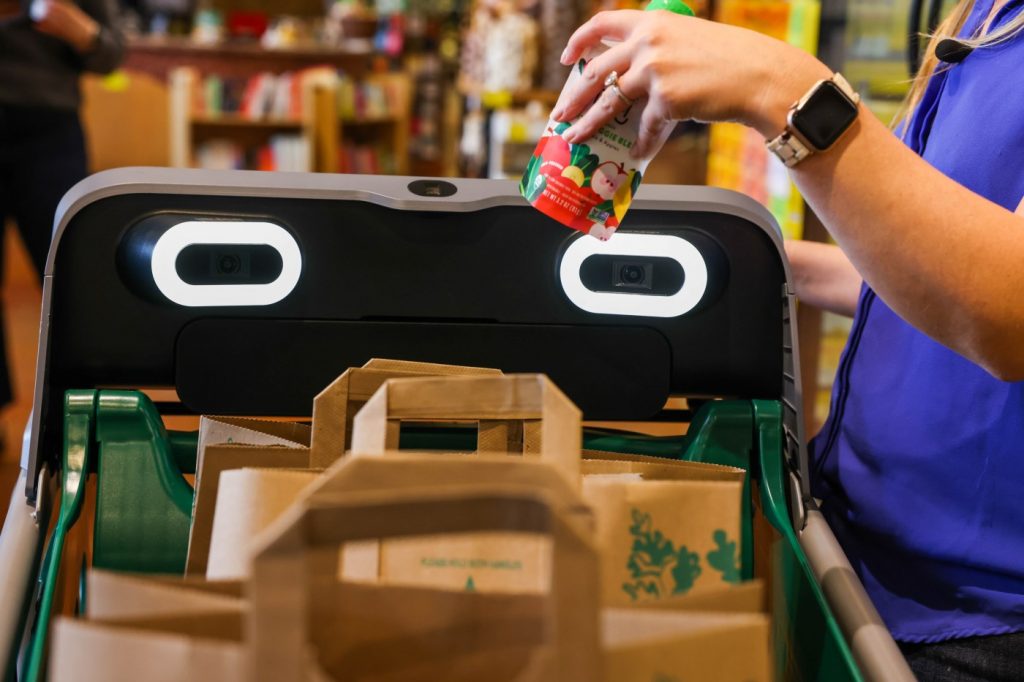American efficiency.
It’s been this country’s holy grail since Henry Ford’s workers timed how long it took to assemble a single Model T (93 minutes).
The word has taken on hallowed tones as an intrinsic good. From writing laws to sorting socks, everyone at some point has sighed and said: “There’s got to be a more efficient way to do this.”
Technology, of course, has brought that mindset into nearly every second of our day. In this quest for a more streamlined life, it’s easy to forget that efficiency often comes at a price, and not just in dollars. And it’s worth asking who benefits from those fabulous efficiencies and who pays that price.
It would be easy to expand on this point with controversial tech advances like cryptocurrency and artificial intelligence, but let’s go to the grocery store instead.
Amazon is promising its customers a more efficient shopping experience with its new Dash Carts, which it’s testing at some of its grocery stores around the country, including Whole Foods in San Mateo. These new carts are loaded with sensors and scanners and touch screens so you can zap and bag your own groceries. When you’re finished, just skip out of the store through a special Dash Cart lane.
The concept sounded intriguing to me, but also nerve-wracking. I have trouble with ordinary shopping carts: I always get one with a wonky wheel and keep jamming it into shelves (and other shoppers). I often abandon my carts, leaving them to fend for themselves in the bread aisle, and never see them again. At self-checkout stations, I bring too many items, mess up the produce and struggle finding bar codes.
But Amazon’s latest technology promised a better future, and so I went to San Mateo for a Dash Cart, delighted to see that all the wheels pointed in the same direction.
Friend or foe?
To operate a Dash Cart, shoppers must first introduce themselves to it via a phone app. I ended up standing by the organic cabbage trying to remember my Amazon password, which was possibly a string of 26 letters, numbers and the unpronounceable symbol used by the late musician Prince. Or maybe it was password1.
Once I was synced up, it was supposed to be a mostly idiot-proof process to glide along, selecting and scanning items and dropping them into the cart. The Dash Cart’s glowing white eyes seemed to track every move, no doubt sneering at my five pints of Candy Bar Ice Cream. I glared back and added another pint.
A touch screen helps shoppers communicate with their Dash Cart and keep track of items. (Ray Chavez/Bay Area News Group)
Each cart is also a hyper-sensitive scale, which makes it a fussy companion. When I took my phone out of my purse, the cart insisted I’d removed a bag of carrot chips instead. When I scanned a baguette and forgot to drop it in, the cart temporarily halted all shopping. And things got a little confusing when I kept changing my mind on my son’s favorite flavor of Lesser Evil popcorn before settling on Himalayan Pink Salt.
Sadly, I saw no carefree skipping through the Dash Cart lane: Nearly every shopper had failed to sync properly with the cart and had to present their credit cards like heathens. I stopped to explain the carrot chip debacle and show my ID for the red wine (purchased for scientific purposes and because it had a chicken on the label.)
Winners and losers
Of course, a learning curve is to be expected. Everything these days has a learning curve, from paying taxes to using a restroom faucet (“Oh, I have to wave my hand this way”). But when new technology is introduced, and is confusing and frustrating, it’s not sufficient to say, “they’ll get used to it.” That puts the onus on the user, and we all feel like we’re failing at life.
So, it’s worth a thought or two why we are adopting a particular change and who it benefits. That a new technology is more efficient is no longer enough. Efficiency should not be the only goal.
Which brings us back to Dash Carts and the key question: Who does the efficiency ultimately benefit?
Related Articles
Hacking at UnitedHealth unit cripples a swath of the US health system: What to know
‘We’re sad that it’s come to this’: OpenAI publishes Elon Musk’s emails
Bay Area business groups may merge as “doom loop” jolts wobbly region
The 5 most exciting innovations coming to an airport near you
Tech company Bay Area property shopping spree tops a half-billion dollars
The carts likely benefit Amazon by bringing people to stores, capturing streams of personal shopping data and reducing the need for cashiers. The last appears especially attractive for Amazon. The more a store can offload any weighing, bagging and checkout duties to the shoppers, the fewer employees needed. So Dash Carts could prove very efficient for stores and their shareholders.
But are they more efficient for shoppers? For certain types — tech-savvy, organized, decisive types with a limited list — Dash Carts can be a godsend. But for distracted shoppers buying two weeks’ worth of groceries with kids in tow … well, less of a godsend. More like another tech minefield of errors in which the shopper later ends up with $100 of Lesser Evil popcorn on an email receipt.
And that’s the thing about today’s high-tech race for efficiency in people’s lives. At least in the beginning, it often works for only a small group. It makes the already efficient more efficient. Perhaps after it’s been alphaed and betaed and gammaed and deltaed, the hackers are foiled and the Congressional hearings are over, the technology will be robust enough to benefit the rest of us.
Until that happy day, however, I’ll be the one at Whole Foods carrying my baguette and looking for my legacy shopping cart with the wonky wheel.
Christine Kilpatrick is deputy opinion editor for The Mercury News and East Bay Times.


